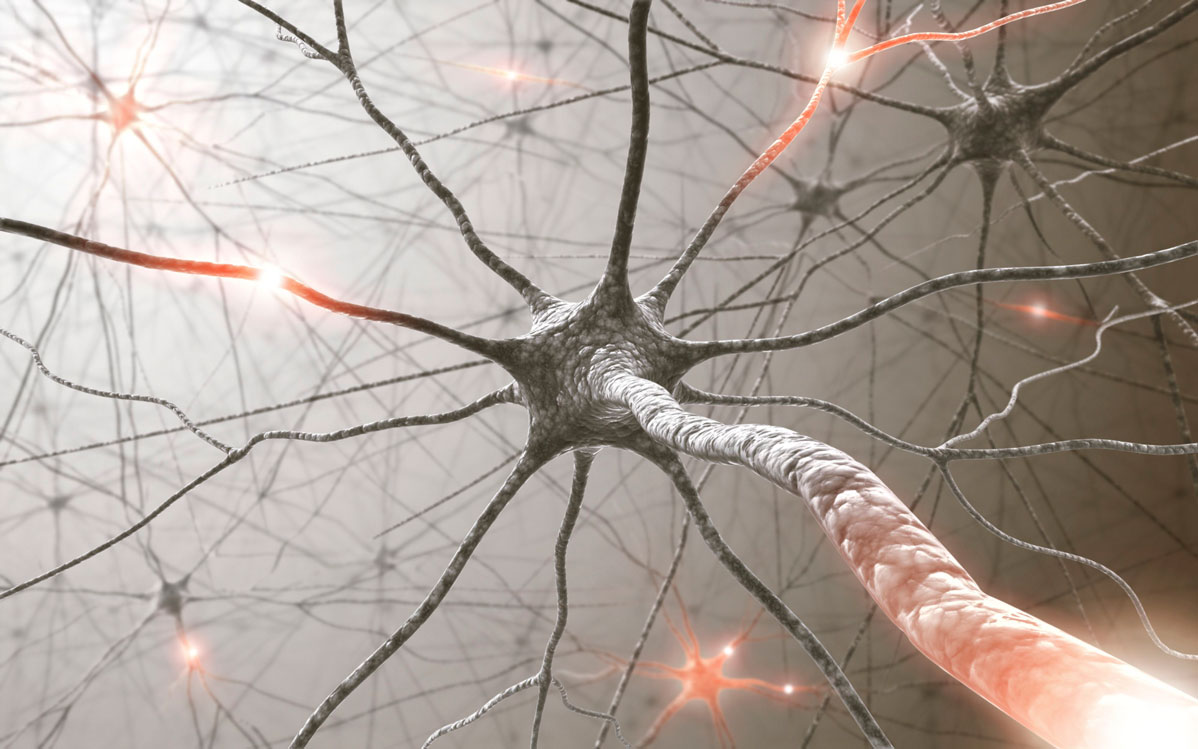Chapter 43. Neural Communication
Learning Objectives

Describe the processes through which neurons communicate with each other.
Contrast the effects of excitatory synapses and inhibitory synapses.
Review
Concept Review
Select the NEXT button to continue with the Review.
1. Neurons are the building blocks of the nervous system. Each neuron consists of a cell body and its branching fibers.
Review
Concept Review
Select the NEXT button to continue with the Review.
2. The bushy dendrite fibers receive information as electrical signals and conduct those signals toward the cell body. Based on those signals, the axon generates a new electrical message and passes it along to the axon terminals. When the message reaches a synapse, chemical signals pass the message across the synaptic gap to other neurons or to muscles or glands.
Review
Concept Review
Select the NEXT button to continue with the Review.
3. The process of neural communication begins when a neuron is stimulated by chemical messages from neighboring neurons. Most of these messages are excitatory signals that increase the neuron's ability to fire (generate a neural impulse), but some are inhibitory signals that block the excitation.
Review
Concept Review
Select the NEXT button to continue with the Review.
4. The neural impulse, called the action potential, is a brief electrical surge that travels down the axon from the cell body toward the axon terminals.
Review
Concept Review
Select the NEXT button to continue with the Review.
5. When the action potential reaches the knoblike terminals at the axon's end, it causes the synaptic vesicles to release chemical messengers called neurotransmitters into the synaptic gap.
Review
Concept Review
Select the NEXT button to continue with the Review.
6. Within a fraction of a second, the neurotransmitter molecules cross the synaptic gap and stimulate a dendrite or the cell body of the next neuron.
Practice 1: Generating a Message
Practice 1: Generating a Message
Play the animation for an overview of the neural communication process.
- Chapters
- descriptions off, selected
- captions settings, opens captions settings dialog
- captions off, selected
This is a modal window.
Beginning of dialog window. Escape will cancel and close the window.
End of dialog window.
This is a modal window. This modal can be closed by pressing the Escape key or activating the close button.
This is a modal window.
Practice 2: Excitatory and Inhibitory Signals
Practice 2: Excitatory and Inhibitory Signals
Play the animation to view the interplay between excitation and inhibition of the neuron.
- Chapters
- descriptions off, selected
- captions settings, opens captions settings dialog
- captions off, selected
This is a modal window.
Beginning of dialog window. Escape will cancel and close the window.
End of dialog window.
This is a modal window. This modal can be closed by pressing the Escape key or activating the close button.
This is a modal window.
Quiz 1
Quiz 1
Select buttons A, B, and C to play segments of an animation about neural communication. Then match each segment with its description. When matches have been made for all the segments, select the CHECK ANSWER button.
- Chapters
- descriptions off, selected
- captions settings, opens captions settings dialog
- captions off, selected
This is a modal window.
Beginning of dialog window. Escape will cancel and close the window.
End of dialog window.
This is a modal window. This modal can be closed by pressing the Escape key or activating the close button.
This is a modal window.
- Chapters
- descriptions off, selected
- captions settings, opens captions settings dialog
- captions off, selected
This is a modal window.
Beginning of dialog window. Escape will cancel and close the window.
End of dialog window.
This is a modal window. This modal can be closed by pressing the Escape key or activating the close button.
This is a modal window.
- Chapters
- descriptions off, selected
- captions settings, opens captions settings dialog
- captions off, selected
This is a modal window.
Beginning of dialog window. Escape will cancel and close the window.
End of dialog window.
This is a modal window. This modal can be closed by pressing the Escape key or activating the close button.
This is a modal window.
Provides an overview of neural communication.
Segment
Shows release of neurotransmitter molecules.
Segment
Shows synaptic vesicles migrating toward the axon membrane.
Segment
Quiz 2
Quiz 2
For each statement, select one of the buttons to indicate whether the statement is True or False. When you have responded to all the statements, select the CHECK ANSWER button
| True | False | |
|---|---|---|
The neural communication process usually begins when the axon receives signals from other nearby neurons. |
||
Excitatory signals make it more likely that a neuron will generate its own electrical impulse. |
||
When the message reaches the axon terminal, an electrical impulse travels across the synaptic gap and stimulates the next neuron. |
||
Inhibitory signals can block the effect of excitatory signals, reducing the likelihood that the neuron will fire. |
Conclusion
